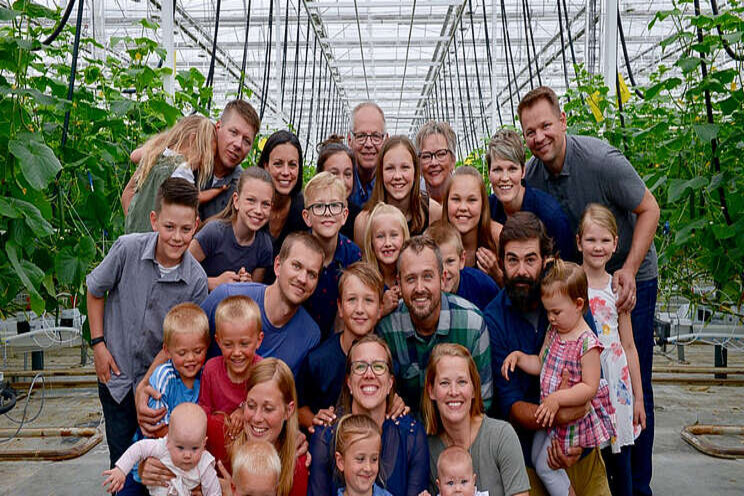Unique partnership a triple play for Lacombe County greenhouse
Added on 31 May 2021

But a partnership between Doef's Greenhouses in Lacombe County and an Alberta energy company has changed that equation.
"Generally oil and gas went about their thing, and agriculture went about their thing," said Brad Murray, president of Horseshoe Power, which has natural gas operations in central Alberta.
"We saw this opportunity. If we work together, if we co-locate our facilities, we can create efficiencies and physically create savings. We can reduce the amount of energy needed. We don't have to transport it as far, and it's there when it is needed."
Murray began making inquiries about four years ago, and eventually Horseshoe Power partnered with the Doef family, which has been in the greenhouse business for 50 years and grows eggplants, short and long cucumbers, and peppers.
After agreeing to partner, Horseshoe Power brought natural gas into Doef's Greenhouses and set up a tri-generation system. A generator running on natural gas produces electricity, heat and carbon dioxide, all of which are used in the greenhouses.
"The advantage of using the well system to power the greenhouses is lower energy costs," said Eric Doef, one of Doef's Greenhouses managing partners. "We're using local gas and we're avoiding distribution and transmission charges from the gas grid and the electricity grid. We're making our own electricity and we're getting waste heat from the engines, because the engine exhaust is 400 C or 500 C. We cool it down and bring that waste heat into the greenhouse."
The system doesn't require burning gigajoules of gas anymore, or the use of a traditional boiler system. And emissions are much lower.
"We're using the natural gas that is right there under the ground," said Murray. "We're using the natural gas system in Alberta to do something good in Alberta, rather than just exporting the raw commodity.
"There's physical savings in terms of energy efficiency and that translates to cost savings."
Many greenhouses use natural gas, but they just burn it to make heat.
"Traditional greenhouses have a boiler, so you run the gas to the boiler, which heats the water which heats the greenhouse," said Murray. "We shut off the boiler. Instead we capture the heat and the carbon dioxide off the generator."
The CO2 is put back into the greenhouse to enhance photosynthesis and plant growth.
"We can grow 10 to 15 more kilograms (of crop) per square metre, depending on the crop type, versus an outdoor grower," said Doef.
Doef's Greenhouses' products are sold at local farmers' markets, and in Sobeys, Walmart and Loblaws stores throughout Western Canada. The operation is only the third co-generation facility in the province and the only greenhouse using this method.
"The other two projects are shipping electricity into the grid, but they aren't connected to the greenhouse," said Doef, adding they looked at both co-generation and tri-generation systems in Ontario and Europe.
"The nice thing about what we have with Horseshoe Power is that it owns and operates the energy centre. So we can focus on growing our crops, and not have to worry about oiling machines and breakdowns in the middle of the night.
"We are in a unique location because there are natural gas wells all around us. The gas is close by, and we have existing marketing channels. We're not a rookie grower, so it made sense."
As their heating and electricity costs have gone down, the Doefs have been able to expand their greenhouse space.
They garnered $2 million from Emissions Reduction Alberta's Food, Farming and Forestry challenge and are embarking on $5.1-million worth of projects.
"My dad started this over 50 years ago," said Doef. "We started super small and had numerous expansions over the years. Before last year, we had 11 acres of greenhouse, and last year, we added 13 more.
"And this year, we are adding another 13 more."
With the system up and running, they're also finding additional benefits
"We use waste heat from our power generator to heat the greenhouse," said Murray. "When that heat isn't needed — like on the hot days of summer — we're going to use that heat to purify water."
This involves adopting technologies that haven't really been used in the natural gas sector.
"That came about when we started working together and we realized how much the greenhouse needs," said Murray. "We have water, but it needs cleaning, and we have heat that we don't need all year.
"By working together, we have more resources to solve things. That's what's really fun and exciting about this."
Finding ways to capture carbon dioxide was the driver, he added.
"You could see carbon sequestration was becoming more important. There was a carbon tax on the horizon," Murray said.
There is a lot of opportunity for other agricultural operations to partner with oil and gas in a lot of different areas, he added.
"Traditionally oil and gas companies would just drill wells and put in pipelines and try to sell them as commodities to North America. As more and more people start to think closer to home, and how we can use it here, to enhance businesses here in an integrated way, I think there's a lot of opportunity."
Photo caption: Joe and Helen Doef's family has grown and so has their greenhouse business. But since partnering with Horseshoe Power on tri-generation, a first for Alberta, Doef's Greenhouses is expanding by leaps and bounds, says Eric Doef (upper right), one of the operation's managing partners. Photo: Doef's Greenhouses
Source: Alberta Farm Express
Source: Alberta Farm Express
More news















